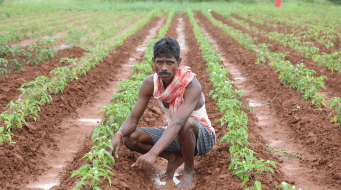By Shreya Banerjee
On this World Desertification Day, we explore the connection between land degradation
and migration
Why is migration a problem?
Migration is thought of as a major development issue, especially in countries like India, which see a large number of people migrating from rural areas to other rural areas or to various urban centres. Migration to urban areas leads to them becoming increasingly overpopulated, with most of the rural migrants working in the informal sector and living in slums and putting additional pressure on resources. Similarly, migration into other rural areas also puts additional pressure on the natural capital in the area and the corresponding ecosystem goods and services.
Migration decisions are influenced by a number of socio-economic, political, cultural, and environmental factors. Usually, migration from rural areas occurs for several reasons, including education, business, marriage, and most importantly for better livelihood opportunities and greater financial security.

Photo Source: FAO website
Land degradation and its influence on rural migration
Rural households depend directly upon ecosystem services for their livelihood to a large extent, whether it is in the form of crop and livestock production or as Non-Timber Forest Products (NTFP). Land-based ecosystems, in particular, provide a number of services to rural communities including providing food through agriculture, preserving forests and biodiversity, acting as a carbon sink, facilitating the natural management of water systems, etc. Hence, the land provides a source of livelihood to many, apart from also providing food, water, and energy security and availability.
Over the years, the physical, chemical and biological properties of land have been changing. This has been happening because of a number of factors, including the consequences of anthropogenic climate change, which refer to an increased frequency of floods, droughts, changes in rainfall patterns etc., alongside other factors like land use changes, unsustainable agricultural and land management practices, commercial development, and other socio-economic and political factors. All of this has been leading to large-scale land degradation, which basically refers to the reduction or loss of the biological or economic productivity of the land resource base.
These rural communities are then forced to come up with other alternative means to earn a living and sustain themselves. In the absence of alternative livelihood opportunities in the area, they are often forced to migrate to urban, peri-urban or other rural areas in search of better livelihood opportunities. In this way, rural communities are forced out of their natural ecosystem, thereby abandoning efforts to restore these areas due to their immediate need for survival. Migration, then often emerges as a coping mechanism for rural communities in response to land degradation and decline in agricultural productivity.
However, the relation between migration and land degradation is in no way, a simple one. Land degradation interacts with several other environmental and socio-economic processes to decrease the productive capacity of land based ecosystems, thus forcing communities to migrate. Moreover, peoples’ adaptive capacity and resilience to changing environmental conditions are linked to various social, economic, political and cultural processes that determine things like income, access to labour markets, social networks, livelihood choices, etc.
Land degradation and migration in drylands
In Egypt, climate change induced sea level rise and desertification affect the Nile Delta, which is the most productive area in Egypt. Because of this large-scale desertification and sea level rise, several people migrated to the Eastern and Western Deltas in search of livelihoods. People who were resettled in the Eastern Delta were mostly unemployed poor men, and those in the Western Delta were mostly sharecroppers who were driven away by certain government policies which were pro-land owners. Several other migrants also came into these regions from other areas and worked as peasants. The sharecroppers and farmers in the Western and Eastern parts were allocated a specific amount of land and were also provided with other incentives by the government who initially wanted to the poor people to migrate to these regions. However, eventually, these regions started displaying soil degradation and water salinity problems. These new landowners then started selling their land and began evicting the migrant peasants who came from other regions. Consequently, the migrants in the Eastern and Western Deltas were again forced to migrate to other areas because a large part of the land suffered from soil degradation and desertification. (Warner, Hamza, Oliver-Smith, Renaud, & Julca, 2010)
Photo Source: www.iosminaret.org; Springer
In Ethiopia, after being faced with continued environmental strains and land degradation with no institutional support, large groups of Mursi people abandoned their traditional lands and cattle, and moved to areas with better rainfall and took up crop farming with limited success.
In these regions, migration is a common coping strategy to deal with environmental and economic strains. However, before they resort to migration, which tends to be the last resort, they try other coping strategies like changing their patterns of consumption, selling off their livestock and other assets, eating less, and depleting their reserves of food for emergency situations.
In drylands, it is noticed that migration decisions are dominated by environmental factors where levels of land degradation is high, and dominated by economic considerations where conditions aren’t so acute.
Land degradation and traditional migratory livelihoods
In East Africa, in order to pursue commercial development, the government was converting a lot of the communal pastoral land into private land. The pastoralists who earlier had large areas to themselves now had very limited and small areas of land. This put a lot of pressure on the grasslands and degraded the pastures, apart from also creating additional competition and conflict with other pastoralists. Eventually, the pastoral communities were forced to migrate to urban centres so they could remit cash back home.
Similarly, in Mongolia, after the government adopted a market economy, the pastoralists in interior traditional areas started migrating to be closer to the towns where they availed cars and sent their children to school. This resulted in certain areas, which were closer to the urban centres, becoming chronically overgrazed and degraded. Hence, in these areas, economic and political forces impacted the environment and eventually led to distress migration. (McLeman, 2017)

Photo Source: Garissa cattle market, Kenya on Flickr
Migration and land degradation in tropics and sub-tropics
In many parts of Amazonia and Southeast Asia, there is large scale deforestation by commercial logging and production companies, farming and plantation enterprises, market-oriented livestock farmers, etc. However, these commercial forestry companies don’t employ indigenous labour, and prefer importing outside labour, leading to in-migration. This also simultaneously uproots and displaces the indigenous population who can no longer pursue their traditional livelihoods. These locals are now forced to migrate to new areas where they may not be able to use their indigenous knowledge for livelihood purposes. (McLeman, 2017)
Hence, we can see that land degradation and a loss of ecosystem services, which is caused by climate change and various other factors, interacts with other social, economic and political forces, to force people to migrate to other areas in search of livelihood opportunities. This migration to other new unaffected regions often causes degradation and depletion of the resources of the new area because of intensive and unsustainable use. Migration to other areas also leads to these migrants being unable to use their traditional indigenous knowledge and take up their original activities for livelihood purposes.
However, this decision to migrate isn’t an immediate and sudden one. When other adaptation and coping mechanisms fail, migration is considered as an option. These migration decisions depend upon each household’s financial resources and access to social networks, which again are determined by their class position, and in the Indian context, their caste position. Hence, socio-economic inequality is an important factor in shaping migration decisions. One can conclude by saying that the connection between land degradation is indeed a complex one that involves multiple, social, economic, political and environmental processes. It depends upon government policies, institutions, rate of industrialization, social structures, apart from the adaptive capacity of households and sustainability of their livelihoods. It also depends upon the availability of alternative livelihoods in the area.
The way forward
On this occasion of World Desertification Day, shedding light on the link between increasing land degradation and migration seems essential. As for ways to combat this land degradation and migration, several strategies are available, some of which have been tried and tested. These might include using Adaptive Sustainable Agriculture, Climate Smart Agriculture, conservation agriculture, organic farming, using district level and village level strategies, creating alternative livelihood opportunities, better institutional facilities and government policies, etc.
Certain studies even suggest that outmigration and remittances are one way of recovering the degraded land and slowing down the process of degradation. However, in most cases, land degradation, along with other environmental and socio-economic factors do cause large scale migration.
In order to tackle this issue, the abovementioned strategies and practices could be used. However, this is not an exhaustive list for an exponentially rising and complicated issue such as land degradation. It would therefore, be more prudent to work towards further innovations leading to countries achieving Land Degradation Neutrality.
Works Cited
McLeman, R. (2017). Migration and Land Degradation: Recent experiences and future trends. Global Land Outlook.
Warner, K., Hamza, M., Oliver-Smith, A., Renaud, F., & Julca, A. (2010). Climate change, environmental degradation and migration. Natural Hazards, 689-715.





